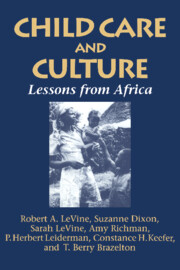Book contents
- Frontmatter
- Contents
- List of tables and figures
- Foreword
- Acknowledgments
- Introduction
- Part I African infancy: Frameworks for understanding
- Part II Parenthood among the Gusii of Kenya
- 3 Gusii culture: A person-centered perspective
- 4 Gusii fertility, marriage, and family
- 5 Pregnancy and birth
- Part III Infant care and development in a Gusii community
- Part IV Interpretations
- Appendix A Fieldwork procedures: Initial phases and planning
- Appendix B Coding categories for spot observations
- Appendix C Blankhart Nutrition Questionnaire
- Appendix D Temperament Assessment Method
- Appendix E Coding categories for narrative observations
- Appendix F Coding categories for face-to-face interaction
- Appendix G Coding categories for maternal teaching task
- Appendix H Supplementary tables
- Notes
- References
- Index
- Plate section
5 - Pregnancy and birth
from Part II - Parenthood among the Gusii of Kenya
Published online by Cambridge University Press: 11 May 2010
- Frontmatter
- Contents
- List of tables and figures
- Foreword
- Acknowledgments
- Introduction
- Part I African infancy: Frameworks for understanding
- Part II Parenthood among the Gusii of Kenya
- 3 Gusii culture: A person-centered perspective
- 4 Gusii fertility, marriage, and family
- 5 Pregnancy and birth
- Part III Infant care and development in a Gusii community
- Part IV Interpretations
- Appendix A Fieldwork procedures: Initial phases and planning
- Appendix B Coding categories for spot observations
- Appendix C Blankhart Nutrition Questionnaire
- Appendix D Temperament Assessment Method
- Appendix E Coding categories for narrative observations
- Appendix F Coding categories for face-to-face interaction
- Appendix G Coding categories for maternal teaching task
- Appendix H Supplementary tables
- Notes
- References
- Index
- Plate section
Summary
Our investigation of Gusii infants began before their birth, to understand not only the family environments into which they were born (Chapter 4), but also to examine the processes of pregnancy and delivery as organized in the Gusii context and experienced by women in the Morongo area. This part of the study focused on 26 pregnant women, who were offered prenatal care at our clinic. Each woman was given an initial physical examination by Constance Keefer, M.D., followed by an interview on aspects of pregnancy and childbirth by a Gusii assistant. During the last month of pregnancy, Sarah LeVine interviewed each woman at home about her domestic activities and social relationships and observed her handling of the toddler who was about to be displaced. The women averaged 29.1 years in age and ranged from an 18-year-old, pregnant for the first time, to a woman over 45 expecting her 13th child.
Clinical examination showed the women to be generally healthy. Their average height and head circumference fell between 85% and 95% of those for adult American women, indicating that previous nutrition and health had been adequate for growth. None were obese, and most were lean and muscular. Despite hunger in the preharvest period and the presence of malaria and intestinal parasites in many of the women, they did not appear debilitated. Sixteen of the 26 women interviewed admitted to drinking alcohol, in small to moderate amounts, and only a few smoked tobacco rarely.
- Type
- Chapter
- Information
- Child Care and CultureLessons from Africa, pp. 121 - 140Publisher: Cambridge University PressPrint publication year: 1994

